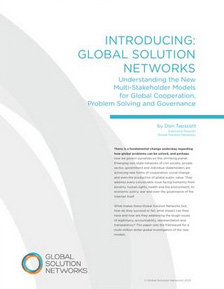Two weeks ago I was on a panel in London as part of Google’s Zeitgeist 2010 event. Also on the panel was Carl-Henric Svanberg, Chairman & non-executive Director of BP. The moderator asked what I would recommend to solve BP’s PR problems. I said that BP has more than just a PR problem; it needs to fix the oil spill. She said fine, how would you do that? I said that I would issue a global challenge, and it appears that BP is trying something along those lines. It is reaching out to a broad range of experts outside of the company, and also their competitors, in order to stimulate fresh thinking.
In a story published June 3rd, Bloomberg Businessweek reported that “BP has received almost 35,000 ideas in just over a month on how best to clean up the millions of gallons of oil from the biggest spill in U.S. history. So far, only four have made it into testing.” Ideas submitted online or by telephone are put through the Alternative Response Technology Triage Process. They are first scrutinized by 70 workers, and the most promising are then reviewed by 43 engineers from BP, the U.S. Coast Guard, and other government agencies.
“If the ideas—which range from soaking up oil with human hair to enlisting oil-eating microbes—are seen as practical and don’t overlap with proposals already being explored, they’re sent to smaller teams of engineers to see if they can be applied,” says Businessweek. “About 800 proposals have made it to this stage, with just one-half of 1 percent of those in testing.” A BP spokesperson said most suggestions are duplicative or infeasible.
The BP Triage Process is looking for solutions to two specific problems: plugging the pipe that is spewing oil into the Gulf, and cleaning up the 2.5 millions of gallons a day that have already escaped. But as President Obama said in his address last night from the Oval Office, the damage to the region goes far beyond the spill itself. Tens of thousands of people have been thrown out of work, from the fisherman who are forbidden to go out to sea to the vendors who supply the more than 1,000 drilling rigs operating in the Gulf that have seen their operations shut down by the federal government’s six-month moratorium on off-shore drilling.
When enormous challenges present themselves, people have come together to share ideas about potential solutions. Humanity has a long tradition of coming together to solve shared problems. The gulf oil spill is a disaster of global scale, so finding a solution is going to require sharing intellectual power on an equally global scale. This disaster cries out for people all over the world – engineers and non-engineers alike – to come together to debate and discuss how best to clean beaches, rescue sea life, revive coastal economies and prevent future spills, as well as any other topic the global community might raise.
Today, thanks to the Internet, we have the tools we need to truly bring the world together in a 21st century agora of ideas. To help address the many broader issues, I have decided, along with nGenera, the collaborative software company, to put online a brainstorming platform asking for suggestions from around the world on how best to help the Gulf recover in the months and years ahead. Click here to go to the site.
Some countries are already experimenting with digital brainstorms. In December 2005, the government of Canada teamed up with IBM to implement Habitat Jam, an online forum that brought together over 39,000 people from 158 countries in a three-day online discussion about urban sustainability. A jam is a massive online discussion that develops actions out of a multiplicity of perspectives and expertise. IBM began online “jamming” in 2001 as a means of engaging its 300,000-plus employees in every facet of the company’s operations—from corporate values to concrete solutions for growth, productivity, and innovation. With Habitat Jam, more than 600 actionable items were brought forth by participants, with more than 4,000 pages of rich dialogue on the problems, challenges, and opportunities of urban development. Ninety-one percent of Habitat Jam participants noted that the process brought together people who otherwise might never share ideas and information.
In a similar vein, the Obama administration is looking for ideas to restore the country’s ailing education system so that it can again be one of the best in the world. You can see the Open Innovation Portal at https://innovation.ed.gov/
So please join us and share your views on what should be done.






Dear Sir, I believe that BP does not take a deep look at the responses submitted to the Alternative Response Technology Triage. However, I just wonder if BP is looking forward to solve the problem for free which I believe the pluging problem has already been solved by a swedish inventor. It seems that nobody cares about that. More information about the invention to be founddontapscott.com at: http://www.eptit.com
Dear Sir, I believe that BP does not take a deep look at the responses submitted to the Alternative Response Technology Triage. However, I just wonder if BP is looking forward to solve the problem for free which I believe the pluging problem has already been solved by a swedish inventor. It seems that nobody cares about that. More information about the invention to be found at: http://www.eptit.com. Does anybody really care?
If the leak is from a straight piece of pipe or if you can get to that then inserting a mandrel tapered hollow pipe with some sort of stop and lip on itonce inserted into the well bore so that you can mechanically clamp it to the existing pipe much like the mechanical jaws they use when adding pipe stands while drilling. Already installed at upper end of this mandrel pipe would be 2 BOP's and once everything was securely in place you could shut those BOP's and stop the flow and devise a more permamnent and secure barrier and clamping system to the exterior of the pipe as well as all of the well heads as I am sure there are more than one at this site. Then you can go about the clean-up scenario and directionally drilling to relieve the pressure and thus abadone this well. This is and will be a major catastophic event if and when it gets into the Gulf gire proceeds east into the Gulstream current and continues out and around Florida and then throughout the eastern seaboard. It will ruin tourism, fishing and it will have long lasting economic consequences. Eventually this will spread to the Grand Banks and those prolific waters for fishing and devastae those economies and cultures that depend on those being rich in product and eventually everyone in America if not foreign fish markets. Then onto Iceland and Europe and the Mediterranean, eventually it will become a permanent part of the North Atlantic gire and thus be the Sargasso seas problem. Maybe in 20 or 30 years after it has devastated all of the life and economies we might be able to gather collect and clean it up there. The way things are going this is really an incompetent showing of otherwise though of profesionals we thought knew their business. Tragically sad! omebody get their head out and do something. Fix the problem first together and then figure out who is to blame but we alredy know the shoddy safety and maintenance record from the 60 minutes interview don't we?
Digital brainstorming is a solution looking for a problem.
We should all contribute our might to solve the shared problems of humanity.